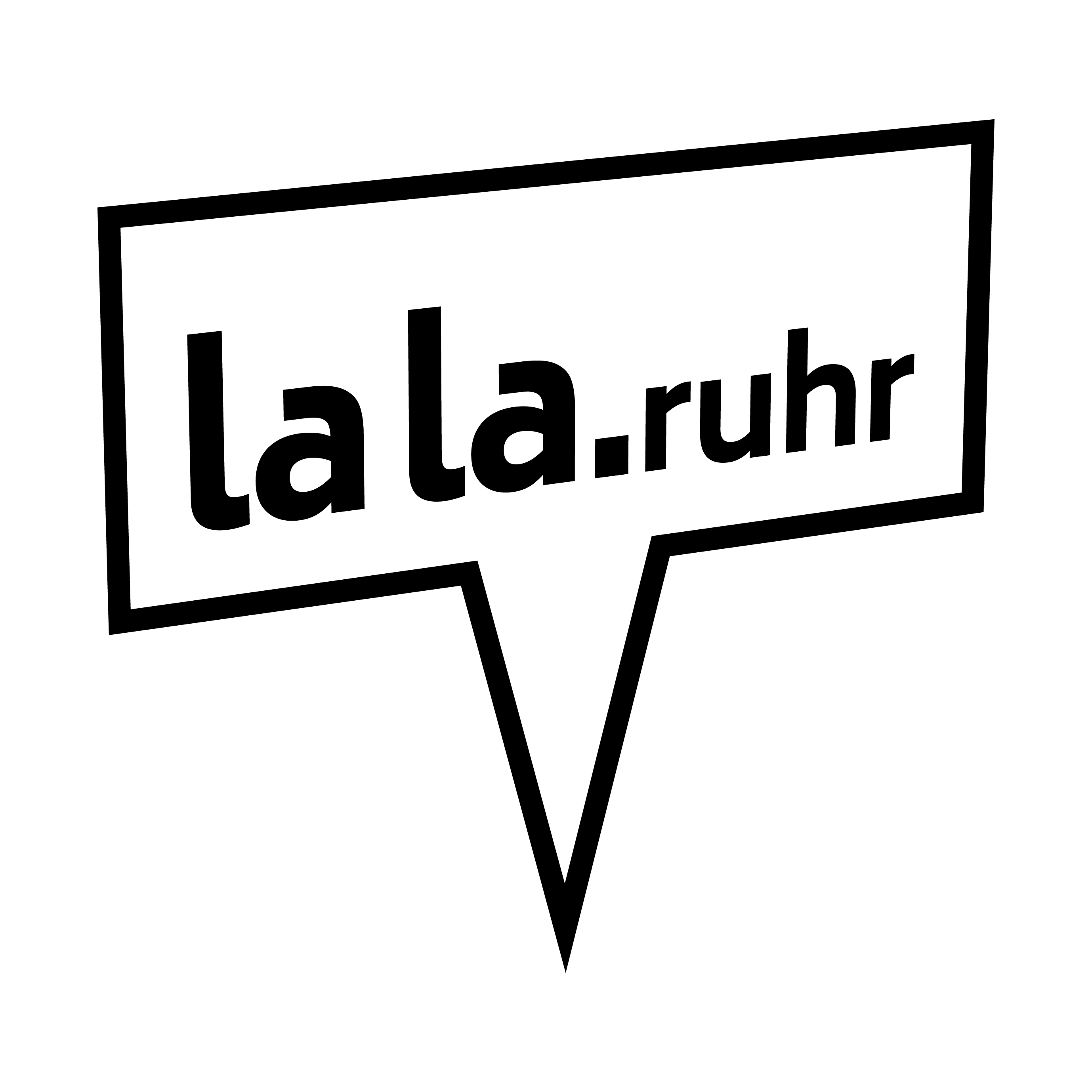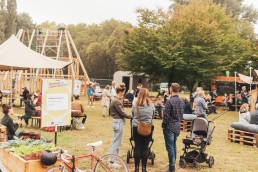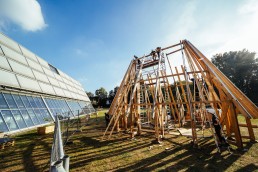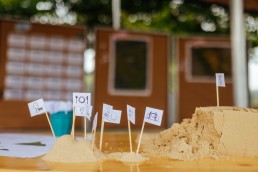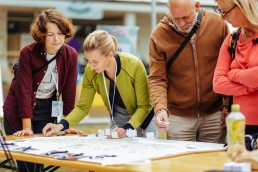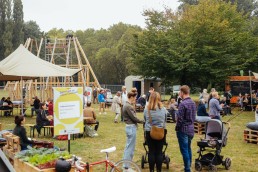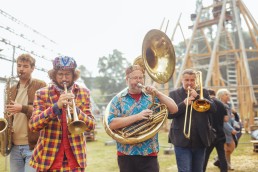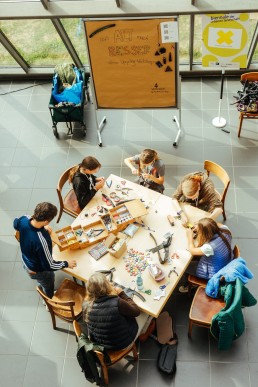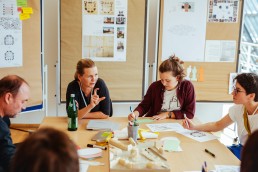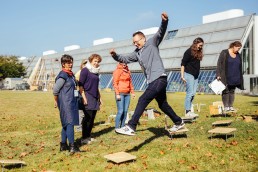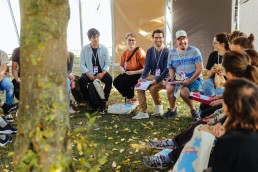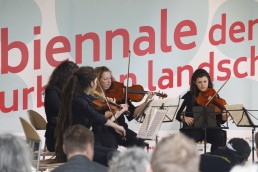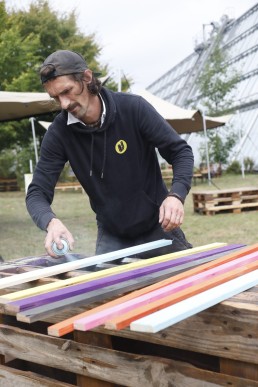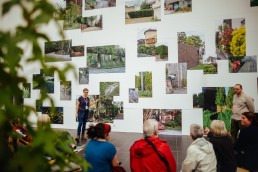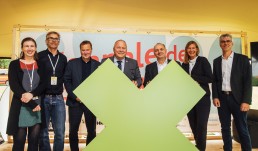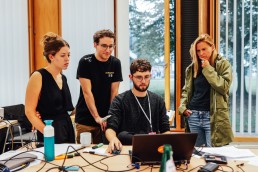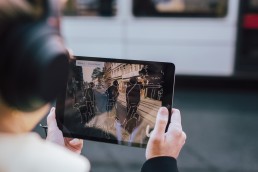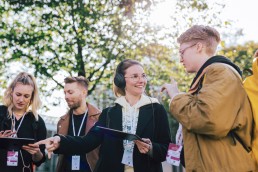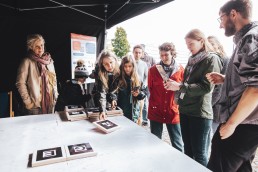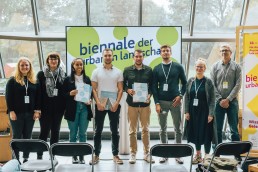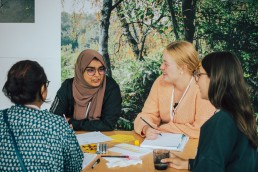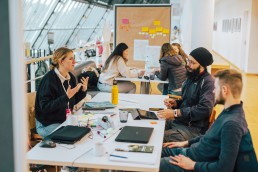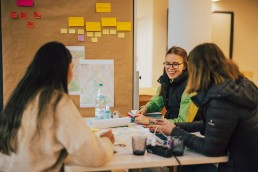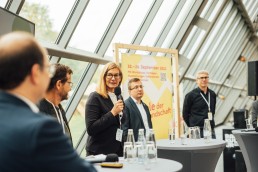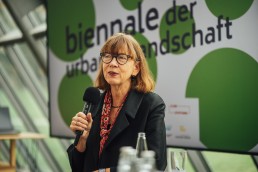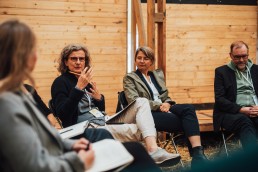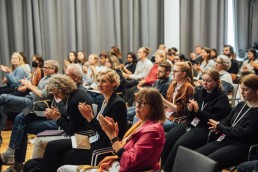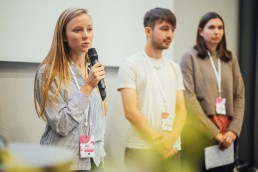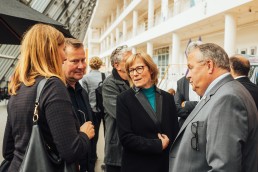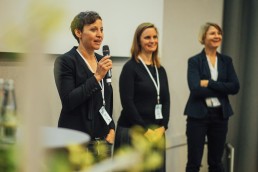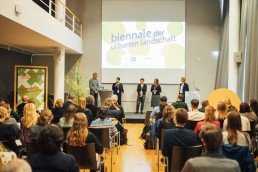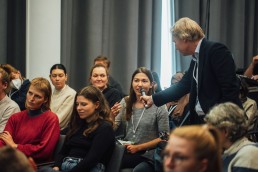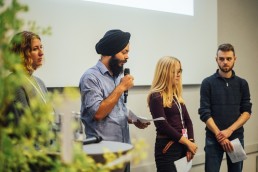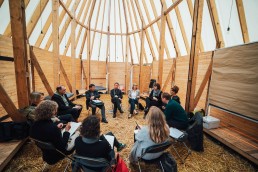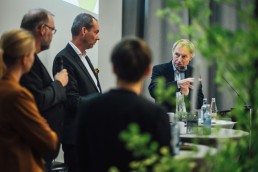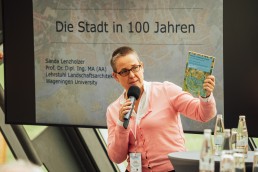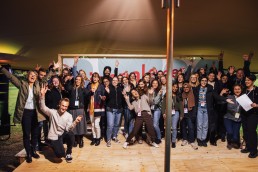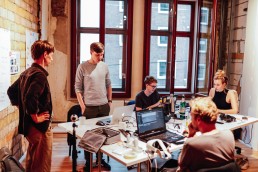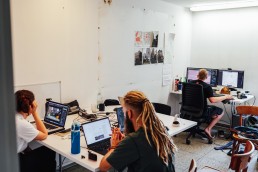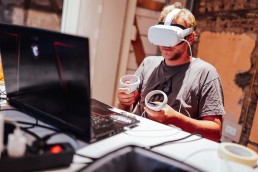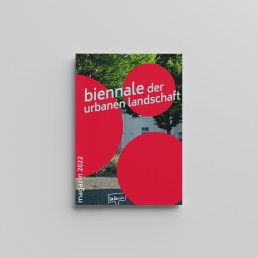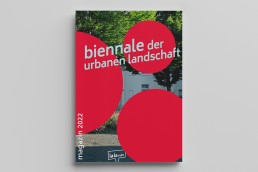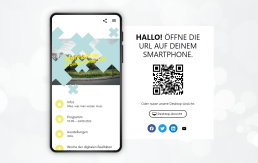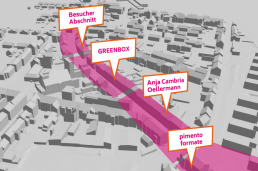biennale 2022 - review of a successful debut
Biennale 2022
- Review of a successful debut
From September 10-24, 2022, the first Biennale of the Urban Landscape attracted grassroots initiatives as much as the big players in planning. lala.ruhr invited motivated people from all disciplines to the festival. 204 contributors jointly offered more than 130 events in and around the Science Park in Gelsenkirchen.
The program and the results of this eventful and intensive 1st Biennale of Urban Landscape in the Metropole Ruhr can now be found with videos, photos and reports on the Biennale website.
Thanks to all who were there, who planned, discussed, built, promoted and celebrated. We could only do that together!
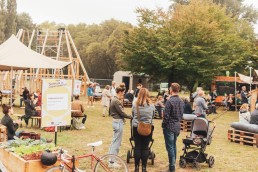
biennale of urban landscape: future needs building culture
Future needs
building culture
Baukultur NRW was involved in the first Biennale of the Urban Landscape with a wide range of program items: discussions and workshops, exhibitions, a Baukultur garden, international cooperations and the temporary urban development pavilion “a-circus”. Graduates of the Kunstakademie Düsseldorf had erected this pavilion on the grounds of the Wissenschaftspark Gelsenkirchen during the course of the festival. At the Biennale, the “a-circus” pavilion clearly symbolized the transformative forces of the urban landscape. In the sense of its temporary nature, “a-circus” travels, always pitching its tent in a new environment, revealing a fantastic world there for a short time – and later moving on. It is a concrete place – albeit temporary – that became an exhibition space, a forum for dialogue as well as a laboratory for sustainable urban development at the Biennale.
Understanding green cities
A city consists not only of houses, but also of the diverse life in between. How do you plan and build for that? A just, livable and sustainable urban landscape is a question of design and thus an important concern of building culture. Addressing the issues involved is relevant to the future. In order for a green future to grow, the Baukultur garden became a symbol and a statement for (green) building culture in the context of the Biennale. Green in the city can achieve many things, and important for this is an active engagement with nature. Only through this can a common understanding of a green, just and livable city emerge. Baukultur NRW had built and planted the raised beds in a cooperation with Grünlabor Hugo; they stood for exchange and urban production at the Biennale. Herbs, salads and vegetables grew there and provided a framework for the current Baukultur debate around the green city.
In cooperation with the Royal Danish Embassy, Baukultur NRW also presented the exhibition “Liveable City” for the first time in Germany, which was developed in collaboration with the Danish Institute for Urban Planning. The exhibition presents 28 successful examples of architecture and urban planning from Denmark, deliberately taking a look at projects outside the largest cities.
Is the urban green becoming a care case?
Baukultur NRW also took a multifaceted look at the green and just city in the other program. In cooperation with Kubia e.V. and the Copenhagen-based architects Dominique & Serena, a workshop focused on the inclusive design of urban spaces and infrastructures for every generation.
In order for green to come into the city, it must be thought about at the very beginning of any project – before planning begins: in Phase 0 of urban design. Baukultur NRW also invited visitors to the “a-circus” pavilion to discuss this issue. On other days, the focus was on the health of city dwellers from the point of view of “The green in care” as well as from the perspective of nature: “Is the city green becoming a case of care?” In urban planning, trade-offs between costs and benefits are central elements, but what is the “benefit” of greenery in the city, what is its cost? Especially under the impact of climate change, these questions came further into the focus of the discussion.
Excursions to the green region
The “Baukultur vernetzt auf Tour” format of the Baukultur-Akteur:innen network made a stop in Gelsenkirchen during the Biennale and was dedicated to the landscape of the Metropole Ruhr. Participants explored the region with Urbane Künste Ruhr, photographer Tania Reinicke and Forststation NRW and focused on disused industrial plants, places of the future, green backyards and works of art along the Emscher and in former churches.
This biennial was about nothing less than “the question of how we can not only preserve the Ruhr region as lovable, but also shape it as a region worth living in,” formulated Peter Köddermann, Managing Director Program of Baukultur NRW
For a long time now, the greenery of our cities has no longer been just a pleasant accessory, but an essential component of urban spaces designed to be sustainable, healthy and climate-friendly. Baukultur NRW would like to encourage people to think about the design of urban spaces and the integration of the important functions of greenery and to negotiate these in concrete terms. Actors in planning, citizens and other stakeholders and interested parties must work together to develop sustainable urban spaces as places to live. With reference to the current climatic developments in the cities, the question of a new approach to green and green planning in the region also arises in building culture.
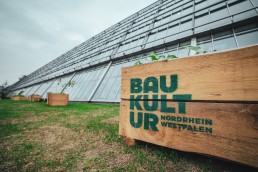
Baukultur NRW was involved in the first Biennale of the Urban Landscape with a variety of program items and encouraged people to think about the design of urban spaces and the integration of the important functions of greenery.
biennale of urban landscape: a weekend of diversity
A weekend
of diversity
Biennale of the urban landscape unites the motivated of all disciplines: mor than 200 actors, from the grassroots initiative to the big players of the Metropole Ruhr design over 130 events from 10-24.9.2022 at the Science Park Gelsenkirchen. We kicked off a successful opening with the “Weekend of Diversity”!
Whoever says "green" must also say "colorful"
Voices on the opening on 10/11.9.2022
“Classical music can rock,” commented Anna Betzl-Reitmeier, artistic director of the Ensemble Ruhr, on the performance by her colleagues – and that’s exactly what the 120 or so guests at the opening of the 1st Biennale of the Urban Landscape experienced firsthand. Furiously and with verve, a sextet of the Ensemble Ruhr introduced the Biennale with Tchaikovsky, which will take place from September 10 to 24, 2022 at the Science Park in Gelsenkirchen. The musicians in this rather unconventional setting for chamber music set the lively tone of the weekend, which remained palpable throughout the events.
During these biennial weeks, more than 180 actors will launch joint actions, present best practice examples and engage in lively discussions with experts and interested members of the public.
Many of them were active on this first “Diversity Weekend”. The rainy weather on Saturday did not dampen the participation in workshops, lectures, discussions and hands-on activities. On Sunday, in bright sunshine, further excursions, workshops and the jazz concert by the Brassholes Marching Band were very popular.
On the opening stage, moderated by the lala.ruhr initiators Sebastian Schlecht and Melanie Kemner, who also conceived the Biennale of the Urban Landscape, Gelsenkirchen’s city building councilor Christoph Heidenreich was pleased that the city of Gelsenkirchen was allowed to host the Biennale: “In view of climate change, we have to get away from silos. That’s no longer possible today, even in city government.”
Nina Frense, Deputy for Environment and Green Infrastructure at the Ruhr Regional Association, who succinctly summarized the transformation of the Ruhr region and its current challenges, also in a global context, added: “Our slag heap landscape exemplifies the transformation of our region through green infrastructure. Created as a waste product of mining, the slagheaps can now become drivers of the energy transition, as sites for renewable energies and as a prime example of how recreation, nature conservation, wind power and photovoltaics can work together in one place. For this, we need creative planners and the courage to break new ground, as we did here at the Biennial of the Urban Landscape.”
The regional power was clearly felt this weekend. The regional, supraregional and also international powerhouse of grassroots initiatives, planners, scientists and artists presented the incredible diversity of commitment to the green city of the future, as well as the activities around the Charter and Strategy Green Infrastructure of the Ruhr Regional Association, which sponsored this first weekend of diversity.
This biennial is about nothing less than “the question of how we can not only preserve the Ruhr region as lovable, but also shape it as a livable region,” Peter Köddermann, Managing Director Program of Baukultur NRW, formulated at the opening… And so, with great seriousness and openness, in the casual flair of the outdoor area and in the arcades of the Science Park, people debated and discussed together, built and experimented, exchanged ideas and looked for solutions to obstacles in implementation. What was special about this was that the unusual setting and the deliberately open formats created such an inviting atmosphere that the exchange between representatives of completely different disciplines and interested parties from outside the field was extremely relaxed and inspiring.
More than 50 program points from the solar roof check to the nature experience area for children, from the field on the parking garage roof to the slag heap excursion, from the upcycling workshop to the university research on the energy turnaround in Germany attracted interested and motivated people from all disciplines on this weekend. Planners and landscape architects, environmental educators and administrative staff, scientists and city makers, but also guests from near and far found their way to the festival meadow with its beach chair made of pallets and straw-filled cushions. They were all united by the desire to learn more about what is most pressing for all of us: how we can make our cities more resilient and climate-adapted as quickly as possible. The bottom line is that there is no shortage of ideas and concrete solutions, but in some places there is a lack of implementation.
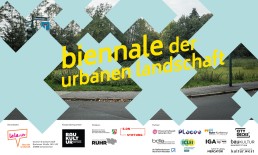
the 1st biennale of urban landscape sets new standards
The 1st Biennale of
Urban Landscape
sets new standards
For two weeks, the first Biennale of the Urban Landscape attracted grassroots initiatives as much as the big players in planning. The initiative lala.ruhr had invited motivated people from all disciplines to this biennial festival. 204 contributors played together in over 130 events in and around the Science Park in Gelsenkirchen.
The opening of the Biennale of the Urban Landscape brought back memories for many participants. The invitation to the Science Park in Gelsenkirchen marked the start of the event at the very place where the IBA Emscher Park began its work more than 30 years ago. Back then, it was the start of a new era. The first biennial succeeded in doing the same: It brought together more than 200 participants and enabled encounters, discussions and actions. The participants included makers of neighborhood projects as well as executives of the IGA 2027; young students as well as state secretaries and scientists. Many of these committed people have few points of contact with each other in everyday life. Unfortunately, because they all have in common that they are committed to the future of the urban landscape in the Metropole Ruhr.
The Science Park as the center of the Biennale
The Science Park Gelsenkirchen was the center of the Biennale for more than two weeks and thus the place of activity of the most diverse actors. The fact that many events took place outside in the park was no coincidence, but rather a symbol. For the focus of the Biennale was the landscape. The initiative lala.ruhr – the laboratory for the landscape of the Ruhr metropolis had invited people to discuss the urban future. In various calls it had called “into the urban forest” and received a huge response from committed people and makers. They all came with creative, scientific, artistic and, above all, hands-on ideas and projects. They created over 130 events, all of which took place in and around the Science Park between September 10 and 24, 2022.
Diversity weekend kicks off
The opening weekend was already marked by change. For the Biennale was about nothing less than the question of “how we can shape the Ruhr as a livable region,” as Peter Köddermann of Baukultur NRW said. This big question stimulated numerous debates, which were conducted with seriousness and openness, with visionary power and a sense of reality. Both in the park and in the arcades of the Science Park, people spent a weekend building and experimenting, discussing strategies and looking for causes of problems and obstacles to further development. The rainy weather on Saturday did not dampen the participation in workshops, lectures, discussions and hands-on activities. The sunny Sunday was ideal for excursions, workshops and the jazz concert of the Brassholes Marching Band, a cooperation with the New Colours Festival.
Excursion into the digital
In the second week, there was a lot of input and output on the ideal interplay between digital and urban design. The focus was on how digital technologies can help develop a sustainable city. A total of 20 young professionals and students from across Europe – including the Netherlands, the UK, Slovenia and France – worked together as part of a “hackathon in residence.” Their expertise ranged from 3D animation, game design, photography and VR programming to urban planning, landscape architecture and data analysis. In four teams, they designed ideas for sustainable developments in urban space. And that was just around the corner. The residencies dealt with problematic places and areas in Gelsenkirchen-Ückendorf concretely and directly on the doorstep of the Science Park. Brownfields, heat islands and street canyons like those in other cities were waiting for their digital transformation.
Visions of students
Young international representatives of planning and design disciplines also came together at the Biennale. The motto “Design for Urban Uncertainties” challenged the interdisciplinary working groups with students from TU Dortmund, TH Ostwestfalen-Lippe and RWTH Aachen University. While some teams worked on the open task on site in Gelsenkirchen-Ückendorf and designed concrete ideas for improving the district, other works remained at a higher altitude. They took a look at the entire Metropole Ruhr and sketched out scenarios of how the former industrial region can become an energy region. The range of ideas, visions and contributions was huge. They were all relevant; they all made it clear on how many levels there is a need for action.
Eine Convention zum Abschluss
Das letzte Wochenende der Biennale stand im Zeichen einer Convention zur urbanen Zukunft. Auch hier kamen zahlreiche Akteur:innen aus verschiedenen Kontexten zusammen und die Impulse, Fragestellungen und Diskussionen waren breit gefächert. Sie reichten von den Ideen der Studierenden, Natur basierten Lösungen für Städte über mangelnde Budgets in der Pflege von Grünflächen bis zum riesigen CO2-Verbrauch in der Bauindustrie; von der Wertschätzung für existierende Pläne bis zur Frustration über Hindernisse, von der Aktivierung kreativer, bottom-up-Potenziale bis zur Skepsis gegenüber Experimenten. Trotz der großen Bandbreite von Sichtweisen machte die Convention der Biennale der urbanen Landschaft deutlich, dass enormer Handlungsdruck besteht. Alle waren sich einig, dass aktuelle Krisen und der fortschreitende Klimawandel die urbane Lebenswelt bedrohen. Deshalb appellierte Anja Bierwirth vom Wuppertal Institut auch schnell zu handeln: „Je mehr wir trödeln, umso schneller kommt der Klimawandel auf uns zu“. Dass es „an programmatischen Ansätzen für Veränderungen“ nicht fehlt, machte Markus Lehrmann als Geschäftsführer der Architektenkammer NRW deutlich. Vielmehr stockt es vielerorts an der Umsetzung. Dass sich das nun ändern würde, stellte Nina Frense vom Regionalverband Ruhr in Aussicht. Sie berichtete, dass die „Charta für Grüne Infrastruktur“ im Ruhrparlament einstimmig verabschiedet worden sei und damit eine neue Verbindlichkeit entstünde. Der langjährige Begleiter der Region, Michael Schwarze-Rodrian, ging einen Schritt weiter. Er blickte auf die IBA Emscher Park und regte an: „Vielleicht brauchen wir wieder einen Werkstattcharakter, also die Offenheit für neue Herangehensweisen, den Mut zum Experimentieren und auch Fehler zu machen.“
Den Abschluss bildete ein „Blick zurück nach vorn” über die Bedeutung regionaler Formate für die Metropole Ruhr und ein Ausblick auf die Zukunft urbaner Landschaften für lebenswerte Städte – auch in 100 Jahren. Prof. Christa Reicher resümierte: „Das Ruhrgebiet hat schon einige regionale Formate erfolgreich umgesetzt. Die Biennale der urbanen Landschaft ist das richtige Format, um wichtige neue Perspektiven zu entwickeln.”
Outlook for next biennials
At the end of two intense and exciting weeks, Sebastian Schlecht, initiator of lala.ruhr, was very satisfied. “We succeeded in discussing very serious topics with fun and many committed people. That is an important concern for us. In this context, this first Biennale of the urban landscape was the prelude,” adds Sebastian Schlecht. The Biennale is conceived as a process and a first and successful kick-off has been achieved. He looks forward to 2024 with great pleasure and invites everyone to help shape the next biennial and, above all, the future of this region.
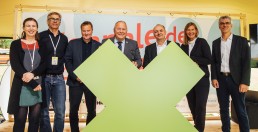
Urban landscape as a community task
Designing a region as a resilient and livable urban landscape is not easy. The 1st Biennale made that clear. But above all, it also showed that this cannot be achieved in isolation. The Biennale not only pleaded for cooperation, it lived it. For the event was only possible thanks to the support of Baukultur NRW, the Ministry for the Environment, Nature Conservation and Transport of the State of North Rhine-Westphalia, the Ruhr Regional Association and the E.ON Foundation. With their support, they all made this great and innovative festival possible. The Science Park Gelsenkirchen was both partner and event center.
Many other people, companies and institutions contributed to the Biennale. These include the Chamber of Architects of North Rhine-Westphalia, the Federal Foundation for Building Culture, the IGA Metropole Ruhr 2027, the Association of German Landscape Architects, City Decks, the Urbanists, Architects for Future, ICLEI Europe, Impact Factory, Jugend Architektur-Stadt, kultur.west, the Düsseldorf Art Academy, the Royal Danish Embassy Berlin, Places _ VR Festival, the Ruhr Conference, RWTH Aachen University, Salon5, Stiftung Mercator, the Technical University of East Westphalia-Lippe and TU Dortmund, the Urban League.
Press material with videos, photos, logos and graphics
Fotos: lala.ruhr/Ole-Kristian Heyer bzw. lala.ruhr/Ravi Sejk Videos: Jerome Chauvistré
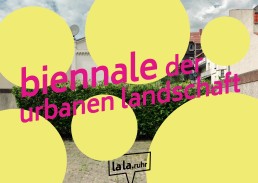
biennale and as well a convention
Biennale
may also
convention
On the last weekend of the 1st Biennale of the Urban Landscape, numerous experts brought important impulses into the discussion about the future of the Metropole Ruhr. The Biennale had invited to a convention at the end. As conventional as the format may sound, the content was equally stirring.
At the start of the convention, Sebastian Schlecht announced that serious topics would be discussed with fun at the Biennale. This even succeeded at the convention at the end of the two-week event. In many different rounds, numerous topics came to the table: from climate change and its threat to the urban landscape, from the variety of existing ideas for the Metropole Ruhr and the obstacles in implementing them, from committed people in the city being shot down with “that won’t work” to the call for a workshop that is open to experimentation and allows mistakes.
Student visions
The convention kicked off with the presentation of student work. In a total of eight groups, students from RWTH Aachen, TU Dortmund and TH Ost-Westfalen-Lippe had worked together for a week at the Biennale. In mixed-discipline teams, prospective spatial planners, urban planners and landscape architects sought solutions for “Urban Uncertainties”.
With this open task, they set out to find approaches for maintaining the quality of life in the Metropole Ruhr. While some groups focused on a conceptual scale and took the particularities of the polycentric region into a new future, others remained more concrete. They made proposals for the immediate surroundings of the biennial venue. They designed pocket parks for Gelsenkirchen-Ückendorf or upgraded the public space to make it a healthy and educational living environment for children. After all, “Children of today […] are adults of tomorrow.” Another group looked for the digital path and designed an app that improves communication between citizens and city administrations. Another team drew not only an ideal image of the city, but also a gloomy scenario; an exhortation to everyone to take the current challenges really seriously.
The future needs joint action
The seriousness of the upcoming crises and the current pressure to act were also pointed out by experts in a panel discussion. Markus Lehrmann, Managing Director of the North Rhine-Westphalia Chamber of Architects, made a stirring statement: “Climate change is nothing new, that is the worst realization. We’ve known about it for 40 to 50 years and we’re not changing anything.”
And the important role that landscape architecture plays in dealing with the current challenges was made clear by Thomas Dietrich as chairman of the BDLA NRW, who praised the Biennale. He said it directed attention to greenery, “which is relevant in all areas. It comes up in all fields of action: in climate adaptation, in creating social justice, in dealing with demography.” But in the Maintenance Case Green workshop, he also made clear that green can only be a solution to problems in urban areas if it is also maintained. And that is a problem, as Melanie Ihlenfeld from Grün und Gruga Essen described: “We are only fulfilling our duty to maintain the traffic; nothing more. That’s what the green spaces look like. Green has degenerated into a compulsory task”. The co-discussants agreed that the financing of care must be redesigned, which requires a constitutional redesign. Markus Lehrmann also turned his gaze to politics. In his opinion, “no one […] is bereft of ideas and programmatic approaches are there, but they have to get through to politicians and legislators.” Finally, Susanne Priebs from TU Dortmund University appealed again: “We need new discourses on the city, like Architects for Future and lala.ruhr are initiating” – in other words, praise for the first Biennale of the Urban Landscape.
We must dare more
Anja Bierwirth from the Wuppertal Institute also made it clear in her keynote speech where action is needed. Her focus was initially on the construction and building sector. Savings could be made everywhere, but not in this area. People still use many square meters per capita for living. But the single-family house is not always a dream, in some cases it becomes a burden. Non-residential buildings also hold potential, Bierwirth explains. We have to clarify how many of them we really use and simplify their conversion. Anja Bierwirth also did not omit to look at public street space and how it is shaped by traffic. She took a critical look at subsidies and appealed to abolish those that are detrimental to sustainable urban development.
At the end of her input, the representative of the Wuppertal Institute demanded that “working methods and processes be accelerated. Everything has to become faster, simpler, more efficient.” In this context, Stephanie Haury from BBSR even dared to demand: “Give money to the municipalities and dissolve the madness of funding structures.” Simplifications are also needed to take the contributions of civic initiatives seriously and value them: “They come to the administration and then it falters. Two- to five-year processes are the death of initiatives.” At the end of the discussion, many agreed: We need more room for experimentation and the courage to make mistakes.
Looking ahead
Christa Reicher from RWTH Aachen University started the last day of the convention with a look at the special features of the region. It is actually the most sustainable model of development, but the Ruhr region consumes twice as much CO2 as the rest of NRW, she explained. She, too, sees an urgent need for action and calls for, “We have to continue such formats [as this biennial] even with shrinking resources. It is a stage for incentive and success, to combine participation processes with top-down strategies.” But she also asks, “How do we need to network to create a creative laboratory?” Other co-discussants wished the same. For example, Mocki Diller from the Ruhr Conference said, “We need openness to other developments […]. We have to allow the spontaneous, also allow bottom-up.” Andreas Giga, head of the future initiative Klima-Werk at the Emschergenossenschaft, also considers something similar to be important: “We must not remain in the subjunctive and always say ‘we would have to and should’ and then go our separate ways and nothing happens.” The representative of the Ruhrbanen Liga also reported similar frustrations: “It is difficult to be taken seriously in dialogue with the city. It takes a lot of effort to communicate to politicians and administrators that we want to be involved in active urban design.”
When asked what would be put in the suitcase for the journey into the future, Peter Köddermann of Baukultur NRW said that he would not fill it, “because we don’t know how to open it. We don’t have an analysis problem, but an implementation problem. There are framework conditions that we have to face, but our structures don’t fit in.” Nina Frense from the Ruhr Regional Association counters this with a positive outlook. With the recently adopted Charter for Green Infrastructure, the Ruhr Parliament has made a commitment “to make everything that is on the table binding.
Transformation in the Ruhr and elsewhere
The last session of the convention started with reports from Sanda Lenzholzer from Wageningen University and Carlo Becker from Berlin. Both looked at other regions and their approaches to urban transformation. In the discussion that followed, Viktor Haase, State Secretary in the Ministry for the Environment, Nature Conservation and Transport in North Rhine-Westphalia, also looked beyond his own nose. He referred to the catastrophes on the Ahr and Erft rivers, “they must make humble” and called for climate protection to be put first. “The crises are growing exponentially, so we need exponentially growing solutions.”
Finally, Daniela Rizzi, with her outside perspective, made it clear that there is no lack of committed people: “If there are people on the ground who feel like doing an event like this, the government should kiss their feet.” In addition, the researcher from Brazil, who came to the Ruhr region while she was still a student, reminded everyone what great, innovative images the region has already put into the world and supports all the committed people in the Metropole Ruhr: “You have everything in your hands to put it into the world.”
With this encouraging call, the 1st Biennale of the urban landscape came to an end. Sebastian Schlecht concluded by pointing out that it is conceived as a process. “We want to develop the biennial further. This was the starting signal, which should find a continuation in two years.”
The convention was sponsored by the Ministry of the Environment, Nature Conservation and Transport of the State of North Rhine-Westphalia.


biennale hackathon: rethinking urban landscape
Rethinking Urban Landscape
Over one week, the four teams competing for the “hackathon in residence” have grown together at breakneck speed. The portfolio of the 20 participants ranges from 3D animation, game design, photography, VR programming to urban planning, (landscape) architecture, data analysis, conception and project management. Smart and creative solutions for sustainable development in urban living space is the encompassing theme. The focus is on sustainable redesign of especially problematic areas in the context of climate change.
Four interdisciplinary teams, four different locations, seven days and probably seven nights: The tight implementation schedule is one of the biggest challenges for the creatives. Immediately after the teambuilding, the discussion moved to brainstorming. In the project rooms provided, colorful Post-Its and flip charts with structure charts and mind maps adorn the plan walls. Brownfields, heat islands and street canyons are ready for their digital transformation. What was already conceptually visible after two days reflects the multi-faceted skills and combined clout of the young professionals and students.
Ückendorf as a project location is unanimously perceived by the participants as inspiring and exciting. Representatives from Switzerland, Austria, the Netherlands and Great Britain, as well as Berlin, Cologne, Wanne-Eickel and Gelsenkirchen themselves appreciate the potential that this district reveals to them for creative free thinking. With the results from this hackathon and the prototypes and ideas developed from it, the Biennale of the Urban Landscape can be a multiplier for other cities in the Metropole Ruhr to tackle the tasks that every surrounding city has to face, planned in a future-oriented and intelligent way.
Hackathon results on show in Ückendorf
The final results were presented to a jury of four experts. The winning team will receive prize money of 2,500 euros. On Friday from 3 p.m. and Saturday from 1 p.m., the general public can also experience these project spots with the prototypes developed – independently or in guided tours. The starting point is the designated info point at the back of the science park.
At the four stations along Bochumer Straße, visitors can immerse themselves in the creative minds’ world of ideas with the help of VR glasses and sound accompaniment. At the same time, the digital journey can also be followed by outsiders on monitors. The project participants will be available for further exchange on site. And the supporting program in and around the Science Park is also well worth seeing. An overview of the many lectures, information booths and workshops can be found in the Biennale program at:
Fotos: Ravi Sejk / Medienmalocher
The Hackathon in Residence is supported by the E.ON Foundation as part of the biennale der urbanen landschaft.
In Kooperation mit:

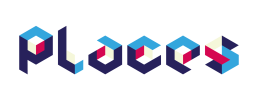

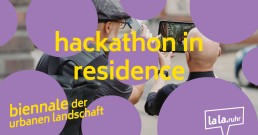
40 pages biennale - the magazine!
40 pages biennale -
the magazine!
For the 1st Biennale of the Urban Landscape, a 40-page magazine will be published that shows the colorful diversity of actors involved in shaping the “City of Tomorrow”. The magazine is available online now and in print at the festival.
The challenges posed by climate change to our cities and urban landscape can only be met if many people pull together. The voices of these “many” can be heard in this accompanying magazine. These are the local and international thought leaders who share innovative thoughts and insights from their work on the city of tomorrow. In sections such as “Portrait” and “Lab,” initiatives, actors, associations and best practice examples from the Ruhr region are presented. In the four-question mini-interview, the Biennale’s cooperation partners are asked about their views, while in the “Point of View” section, the content flies a little higher to put the Biennale’s themes in a broader context.
In addition, a glossary brings clarity to newer buzzwords and trendy buzzwords surrounding urban landscape. Figures, data, facts shed light on the question “How green is the industrial region?” and a pinboard spotlights some of the many initiatives, companies and activities in the Metropole Ruhr that help shape the urban landscape every day. Photographs from the Mapping the City exhibition and a slam poetry text give a taste of how the urban landscape is reflected in words and images on an artistic level.
Also available in print at the Biennial of the Urban Landscape and at the lala.ruhr office!
Program launch for the 1st Biennial of the Urban Landscape
Program launch
for the 1st Biennial of the Urban Landscape
Program launch for the 1st Biennial of the Urban Landscape
Here it is, we have published the program for the 1st Biennial of Urban Landscape! The Biennial will take place from September 10-24, 2022 and will include three intensive weekends and two active working weeks. All events are free of charge. You can find the program in our Biennale app lala.ruhr/biennale-programm. Here you can also register for events with a limited number of participants.
About the Biennale app
With the web app of lala.ruhr all information, programs and actors are directly available without download and installation. The app is optimized for smartphones, but works on any device. Practical: Users can mark interesting program points and thus compile their own biennial program. Current program information is communicated here and participants can chat and network with each other.
The central question is how we can make our cities resilient, livable and fit for the future.
September 10-11: Diversity Weekend
This is a meeting place for everyone who wants to actively work on the green future: interested people and experts, planners and administrators, scientists and city makers – motivated people from all disciplines. The content ranges from actions in the neighborhood to philosophical and political debates to concrete urban development and design of the green city of the future. There will be lots of workshops, lectures, presentations, panel discussions and excursions on “green infrastructure”, and building, screwing and gardening will be done together to create the festival center at the Science Park Gelsenkirchen.
September 12 – 17: Digital Realities Week
Digital is better? Not always – but digital technologies can help to develop a sustainable city in which its inhabitants live better. That’s why the “Week of Digital Realities” will feature both input and output on the ideal interplay between digital and urban design. In a week-long hackathon in residence, several teams will develop concrete solutions to real-world problems using VR, AR, Big Data and AI. In parallel, there will be a wide-ranging lecture program.
September 18: Field Trip Day
Expedition to the Ruhr region! With our cooperation partner Baukultur NRW and with Urbane Künste Ruhr we start a journey of discovery through the region on different paths.
September 19 – 24: Week of Visions
With the ideas of the students from the Campus Week (September 19 – 23) under the title “Design for urban uncertainties”, an international weekend of competencies, frameworks, solutions and visions for a green regional future will start on Friday, September 23. Green strategies and real-world solutions will be discussed from global and local perspectives. Experts will look back on the past successes and visions of the Ruhr region, discuss the current projects of the Ruhr-Conference and conclude by talking about the landscape as a basis for an urban and regional future – because it starts now.
24 .September: Closing ceremony with green picnic
The end of the Biennale is the beginning of the future. What could be better than celebrating and enjoying this departure together?
Baukultur North Rhine-Westphalia
As a cooperation partner of the Biennale of the Urban Landscape, Baukultur NRW is contributing its own curated program section with current building culture topics in a total of 16 event formats to the Biennale program. The venue is the pavilion “a circus”, a project of the Baukunstklasse of the Art Academy Düsseldorf, which has found its place on the Biennale site Wissenschaftspark Gelsenkirchen. A arena that is open to actors, partners and players as a meeting place for further thinking about the “green city”. Baukultur NRW understands itself as an actor in the center of the thematic diversity of the Biennale and connects the current questions, tasks and expectations of building culture with the green and livable urban region in climate change.
You can access our Biennale app at: lala.ruhr/biennale-progamm
BIENNALE 2022 - Hackathon in Residence
Call:
Hackathon
in Residence
*CALL CLOSED* We are looking for curious and open-minded people from different disciplines. Whether you are a landscape architect, architect or urban planner, game designer, programmer, maker, specialist in geodata and LoRaWan sensors, or you are interested in XR, VR, digital art and other interfaces between digitality and the reality of the city.
As part of the first Biennale of urban Landscape, we are organising a “Hackathon in Residence”. From 11.09 – 18.09.2022, we invite people from different disciplines (architecture/planning, IT/digital, art/creative economy) to Gelsenkirchen-Ückendorf. Along the Bochumer Straße, 5 public places will be “worked on” by the teams. We offer expense allowance, accommodation, food and the chance to win prize money.
Live and work for a week in one of the most exciting urban quarters of the Ruhr area. Work in an interdisciplinary team on a challenge for the green city of the future. Present yourself and your ideas to the public.
We want to find out how digital technologies can help us design better, greener and more people-friendly cities.
Application deadline is 15.07.
All information in the Info-PDF:
The Hackathon in Residence project and the biennial of urban landscape sponsored by the E.ON Foundation
In cooperation:



The Hackathon in Residence project and the biennial of urban landscape sponsored by the E.ON Foundation

In cooperation:



The first Biennial of Urban Landscape!
OPEN CALL!

The first Biennial of Urban Landscape!
It’s official: From 10-24 September 2022 lala.ruhr is organising their first Biennial of Urban Landscape – an international festival on the green city of the future!
Everyone is welcome to discuss and develop ideas and solutions at workshops, exhibitions and excursions. Join us in the heart of the Ruhr region, in the creative neighbourhood Gelsenkirchen Ückendorf.
Find out more on our new website: www.lala.ruhr/en/biennial
Want to keep updated? Follow us on Instagram or Linkedin and sign up for our newsletter!
STAY TUNED!
you want to know what's going on?
Join our newsletter list and we'll keep you up to date.
Our contribution to the Places VR-Festival - XR in urban planning!
Our contribution to the Places VR-Festival - XR in urban planning!
Under the motto “Imagine Urban Green Futures”, lala.ruhr invites you to discover the inner courtyard and the visionary garage workshops: We will present digital innovations in spatial planning with images, videos and animations, and in the garages you can meet the technology partners, programmers and artists at work. The green courtyard and its garages will be transformed into an inspiring green lounge for two days.
Opening on September 17th at 14.00 o’clock in the courtyard of Bochumer Straße 110 in 45886 Gelsenkirchen!
The project “Imagine green urban futures” is funded by the E.ON Foundation. Together, we want to test the concrete use of augmented reality in urban planning in order to give new impulses for participation and citizen involvement – so that the city of the future can be experienced and the debate about it becomes lively.
How do we want to develop our cities for the future? lala.ruhr invites you to the Quartiersoase and presents lots of inspiration around digital tools and interventions for planning and participation.
- Talk and exhibition on VR and AR in urban and landscape planning and for participation formats in urban development.
- Introduction to the AR project “Imagine Green Urban Futures” along Bochumer Straße
- Meet the artists
- Showrooms and workshops for digital planning tools
On-site participants include: Stephan Muschick (E.ON Foundation), Stefanie Hugot (Head of the Urban Planning Department at the City of Gelsenkirchen), Dr. Volker Settgast (Fraunhofer Austria), Hilke Berger and Immanuel Schipper (HafenCity University Hamburg), Matthias Funk (scape Landschaftsarchitekten GmbH), Burkhard Drescher (Innovation City Management), Prof. Dr. Ismeni Walter (Ansbach University of Applied Sciences) & Michelle Adolfs (Team Greenymizer VR), Jan Kamensky (Hamburg), Elle Langer and Markus Mende (pimento formate), BIMa.solutions – Virtual Reality for Architecture, Sebastian Witt & Robin Römer (Cityscaper Aachen)…
Friday, September 17, 2021
Opening hours 14 – 20
Saturday, September 18, 2021,
Opening hours 10 – 18 h
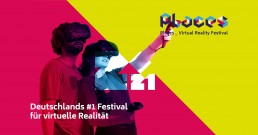
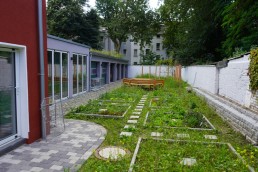
The Quartiersoase, in the backyard of Bochumer Straße 110 is one of the many extraordinary locations of the Places _ VR festival.
Imagine green urban futures: the teams have been selected!
Imagine green urban futures: the teams have been selected!
The participants in the “Imagine green urban futures” competition, which was looking for technology-savvy planners and designers, have now been selected: the teams of lala.ruhr and the Places _ VR Festival are pleased to welcome the agency pimento formate, the landscape architecture firm GREENBOX and the scenographer Anja Cambria Oellermann to Gelsenkirchen-Ückendorf.
The jury, consisting of Sebastian Schlecht (lala.ruhr), Daniela Berglehn (EON.Stiftung) and Thomas Dietrich (Chairman of bdla NRW), decided in its digital session on the three applicants from a large number of submissions, each of whom brought exciting and different approaches to the task of developing a green and sustainable vision for Bochumer Straße based on 3D data.
The Berlin agency pimento formate, with its team led by managing director Elle Langer, wants to focus on edutainment for sustainability and playfully inspire people to articulate their ideas for green house facades, locations for urban gardening and the like and to record them with the help of self-shot augmented reality stories (AR).
The team from the Cologne office Greenbox Landschaftsarchitekten, led by Felix Brennecke, applied with the idea of thinking urban planning vertically with the help of an AR application and thus using the street or urban space on several levels.
Anja Cambria Oellermann, a scenographer from Hamburg, wants to use AR to promote the discovery of the environment, for example by showing changes in the city’s nature when it rains.
The three selected participants now have one month to realise their respective visions in 3D before cityscaper, the project’s technology partner, converts the data into AR applications. Visitors to the Places Places _ VR Festival (17 & 18.09.2021 in Gelsenkirchen-Ückendorf) can then explore the results via smartphone or tablet.
The project “Imagine green urban futures” is funded by the E.ON Foundation. Together, we want to test the concrete use of augmented reality in urban planning in order to give new impulses for participation and citizen involvement – so that the city of the future can be experienced and the debate about it becomes lively.
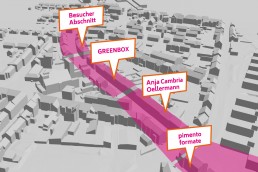
Division of Bochumer Straße
